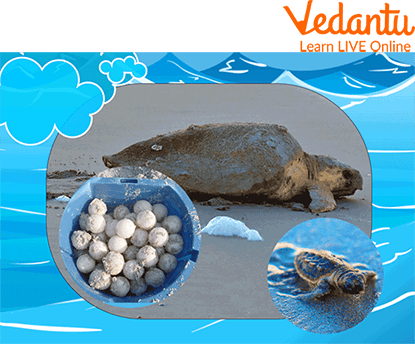




Overview of Sea turtle
Kids, can you name an animal that lives in the ocean and has been around for over a million centuries? They lived even before the Dinosaurs and had the great power of holding their breath under the ocean for 7 hours. Well, there are various ancient aquatic animals, but the one which can hold its breath for hours under the water is the Sea Turtle.
Well, in this article, we will get you through sea turtle facts for kids that would blow your mind. Let’s dive in and learn some interesting facts about these amazing creatures.

Showing the Sea Turtle of the Indian Ocean
Physical Characteristics of Sea Turtle
The physical characteristics of a sea turtle might vary as per their species. They are widely known for their huge streamlined shells, immovable head, and limbs. Compared to the turtles living on the earth, ocean turtles cannot turn their head around or move their limbs.
They have tough and big shells, which makes them vulnerable to predators. The body's upper portion is called the carapace, and the lower part is called the plastron. Most species of a turtle have a shell except for a few species, which are covered by thorns called scutes. The species are categorised based on the number of appearances of the Thorns on their body and their structure.
The leather Turtle got its name because they have leather- Like shells and not tough thorny shells like most others. The hawksbills have a straight and sharp beak for which their name is how bills. Loggerheads are known for their head which supports the powerful jaw making them chew hard food or shells of their prey. Some species of turtle are named after their colour: the Green Turtle got its name as it has green cartilage, and the Olives Ridley Turtle has an Olive coloured shell and is thus named after it.
Where do Sea Turtles Live?
Sea Turtles can be found in all oceans except for the polar regions. They are known for their migratory patterns. Leatherback Sea Turtles are one of the most migratory, crossing the Atlantic and Pacific Oceans. Pacific leatherbacks migrate from nesting beaches in the Coral Triangle to the California coast.
Hawksbills are mostly tracked down throughout the tropical seas, dominatingly in coral reefs. Whereas Green Sea Turtles live for the most part in tropical and subtropical waters. Long Heads are the most widely found turtle in the Mediterranean, settling on sea shores from Greece and Turkey to Israel and Libya.
What do Sea Turtles Eat?
Some species of sea turtle are herbivorous, for example, the green Turtle, while some are found to be omnivorous, but as they age, they shift to being herbivorous. Some species use their v-shaped shaped sharp jaw to eat various aquatic prey, light algae and sea grass.
Some species can eat both plants and animals. Kemp's Ridley, Olive Ridley, Blockhead, and Hawksbill Sea Turtles are omnivorous, eating a wide assortment of the two plants and creature life, seagrasses, kelp, wipes, molluscs, worms, and fish, and are remembered for their eating regimen.
Why do Sea Turtles Come Ashore?
Most female sea turtles come ashore to dig their nest and lay their eggs to protect them from dangerous aquatic animals. They lay their eggs in moist sand as they come ashore on the lands of various beaches. Though it seems only female turtles come ashore, in some countries with lower temperatures or the polar regions where the water is freezing, turtles of both genders may leave the water and come ashore.
Also, ocean turtles are cool-blooded, and they need to regulate their body temperature by 3° C. Some research has found that coming ashore may help a turtle have good immunity, digestion, and fertilisation, and even protect them from any courtship.

Sea turtle Being on Shore for Nesting.
Conservation of Sea Turtles
A huge number of animal conservation teams are working towards saving the lives of turtles and protecting them from extinction. WWE is working towards preserving Sea Turtles from various illegal trade practices, including their selling and consumption. According to their research, these titles are mostly extinct because of their homes being destroyed where they nest or hunt their prey.
Quick Sea Turtle Facts for Kids
Now, let’s have a look at some interesting sea turtle facts.
Ocean Turtles have been around longer than dinosaurs.
Their shells have north of 50 bones.
The existence history of an Ocean Turtle is written in its bones.
Ocean Turtles have no teeth.
They can travel staggeringly significant distances.
Ocean Turtles have their own navigations.
Some Ocean Turtles make burping sounds.
Ocean Turtles can pause their breathing for as long as seven hours, all at once.
Summary
In this article, we learned that Sea Turtles are one of the oldest creatures found on the earth; the fossilised remains are 120 million years old. They have huge bodies. They mostly stay in the ocean but may come ashore to lay eggs or regulate their body temperature. Further, we learned that these Sea Turtles could either be omnivores or herbivores, depending on the species. We also learned about its conservation status and read some Sea Turtle facts for kids.
FAQs on What is a Sea Turtle?
1. What is the lifespan of a sea turtle?
What we can be sure of is that ocean turtles carry on for quite a while (some can satisfy 50 years or more) and have comparable life expectancies to people. Most marine turtles require a very long time to develop, somewhere in the range of 20 and 30 years, and remain effectively regenerative for an additional 10 years.
2. What is special about a Sea Turtle?
Ocean turtles played essential parts in keeping up with the strength of the world's seas for in excess of 100 million years. These jobs range from keeping up with useful coral reef biological systems to moving fundamental supplements from the seas to sea shores and waterfront hills.
3. What number of ocean turtles are left?
Late estimation shows us that almost 6.5 million ocean turtles are left in the wild, with totally different numbers for every species. For example, populace gauges for the fundamentally imperiled hawksbill turtle range from 83,000 to conceivably just 57,000 left around the world.









